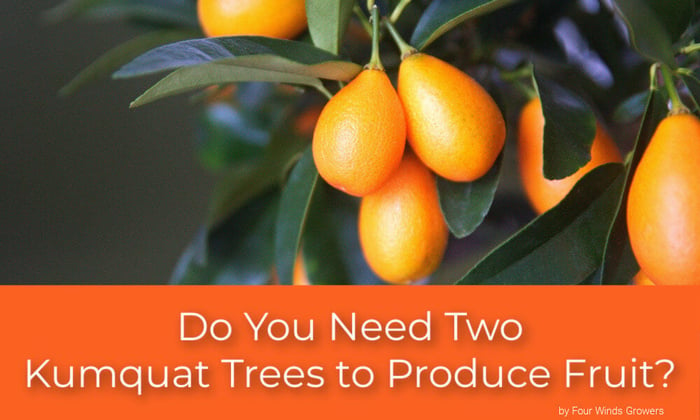Table of Contents
What is a Kumquat?
The Kumquat is a native Chinese citrus fruit known for its tart-sweet flavor and small, adorable size. This cold hardy variety is ideal for cooler climates and, when potted, for small outdoor spaces.
These citrus fruits may be small, but they carry big symbolic meaning, especially in Chinese and Southeast Asian cultures. Often associated with prosperity and good fortune, the word for kumquat in Chinese, jīn jú (金桔), literally translates to "golden orange," linking the fruit to wealth and abundance.
Their bright, cheerful color represents joy, optimism, and positive energy, making them a popular decoration during Lunar New Year celebrations. Because the fruit is eaten whole, their unique sweet-and-tart balance symbolizes resilience and the ability to embrace both the sweet and sour moments of life. They also represent fertility and family, as the trees are generous fruit-bearers, symbolizing a fruitful and thriving household. These small but mighty citrus fruits are associated with health and longevity, and rich in vitamin C.
In feng shui, placing a potted tree by your front door is believed to invite happiness and prosperity into your home. With all these layers of meaning, kumquats are more than just a tasty fruit, they’re a symbol of vibrant, abundant living.
The trees are self-fertile with an upright growth habit and rounded canopies, trees grow tiny, white aromatic blossoms in the spring which set fruit that can be harvested typically November-April, depending on the variety.
The fruit themselves are very small, about 1"-2" in length and referred to as "little golden gems". You eat them, peel and all. The peel is the sweeter component and the juice is tart and sometimes sour. Most varieties have seeds, which should not be eaten.
Like all citrus plants, Kumquat trees thrive in well-draining soil, 6-8 hours of south facing direct sun, and protection from frost. Foliage and flower growth can be encouraged with early spring fertilization, followed by a regular feeding schedule throughout the spring, summer and early fall. They can also successfully be grown indoors with proper indoor citrus care, such as adequate light exposure and proper watering practices.
Click here to read "How to Grow Citrus Trees in Containers"
The main species of kumquats available are: The Meiwa, Nagami and the ornamental Hong Kong Wild. In addition to these, there are many unique varieties of hybrids.
Read more about the 8 Great Kumquat Varieties that we grow here at Four Winds Growers:
1. Nagami
The most popular variety in the US. Medium, oval sized fruit with a bright orange, thick peel and a sweet-tart pulp and juice. A nice balance of flavors. The Nagami tree is attractive, with an upright growth, thin, dark shiny leaves and a fast growing nature.
2. Marumi
This ancient Chinese variety has small, round fruit with a thick yellow-orange rind. Very juicy. Not a common commercial variety.
3. Meiwa
This variety is a hybrid of the Nagami and the Marumi. Large, round fruit with a smooth, thick rind and sweet juice. This is the most popular variety in Asia, and great eaten fresh.
4. Nordmann Seedless
Similar size and flavor to Nagami, with lighter skin, a teardrop shape and no seeds. Medium sized yellow-orange fruit, thick rind, sweet; pulp tart, fairly juicy. Tastes just like Nagami, but is seedless.
5. Fukushu
This variety is a hybrid of the kumquat and the mandarin and is commonly candied in China. This tart and juicy fruit is large and round, with a thinner edible peel. The tree is one of the most attractive of the kumquat varieties, Leaves are rounded and delicate.
6. Centennial Variegated
This Four Winds favorite is a beautiful ornamental tree that produces large sized, striped kumquat fruit. The tart and juicy fruit is oval with a slight neck and thin rind. It is green striped when young and ripens to a light orange color. The leaves are small, delicate and striped, which makes it very striking among other green citrus trees.
7. Eustis Limequats
Just as the name suggests, the Eustis Limequat is a hybrid of the Marumi and a West Indian lime. The oval fruit and thin yellow peel have a tart-sweet, acidic flavor, almost identical to a lime. This ornamental tree is more cold hardy than a typical lime tree, and a good option for those who can not grow limes. The fruit is small, seedy but very flavorful.
(This is a favorite of mine personally, as it is the perfect amount of lime juice to squeeze into my iced water or iced tea)
8. Indio mandarinquats
An ingenious cross between a Nagami and a Dancy mandarin. Its large, bell shape and bright-orange peel make this tree very beautiful as well as practical. Indio mandarinquats are a sour variety and taste best in beverages or as a marmalade. The mandarin qualities in this variety makes the color of the rind a striking dark orange and the flavor of the juice unique and delicious.
BONUS VARIETY:
Calamondin- The calamondin, or Calamansi, as it is called in the Philippines, is a hybrid that is not only ornamental, but grows delicious, addictive calamondin fruit for beverages, soups and dressings.
The fruit is small, round and has a unique sour mandarin-lime flavor. The itself tree is considered ever-bearing, meaning that under optimal growing conditions (USDA Zones 8-11) is can flower and fruit throughout the year. A mature tree can produce hundreds of calamansi fruit in a harvest.
The peel is not eaten unless candied, and this fruit is typically juiced. This variety also comes in a lovely, variegated variety. Not only are the tiny leaves variegated with greens and cream, but the immature fruit is also stunningly striped, and then turns a bright orange when it is ripe.
Do you have any questions about growing kumquats? Don't hesitate to email us!
cs@fourwindsgrowers.com
sources:
"Varieties of kumquats, hybrids"
"Planting Kumquat Trees in Containers"




